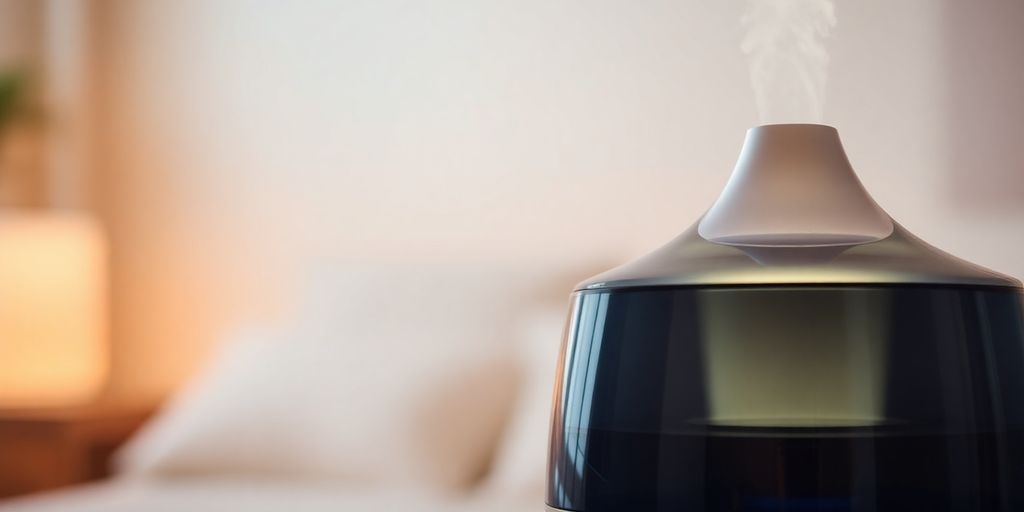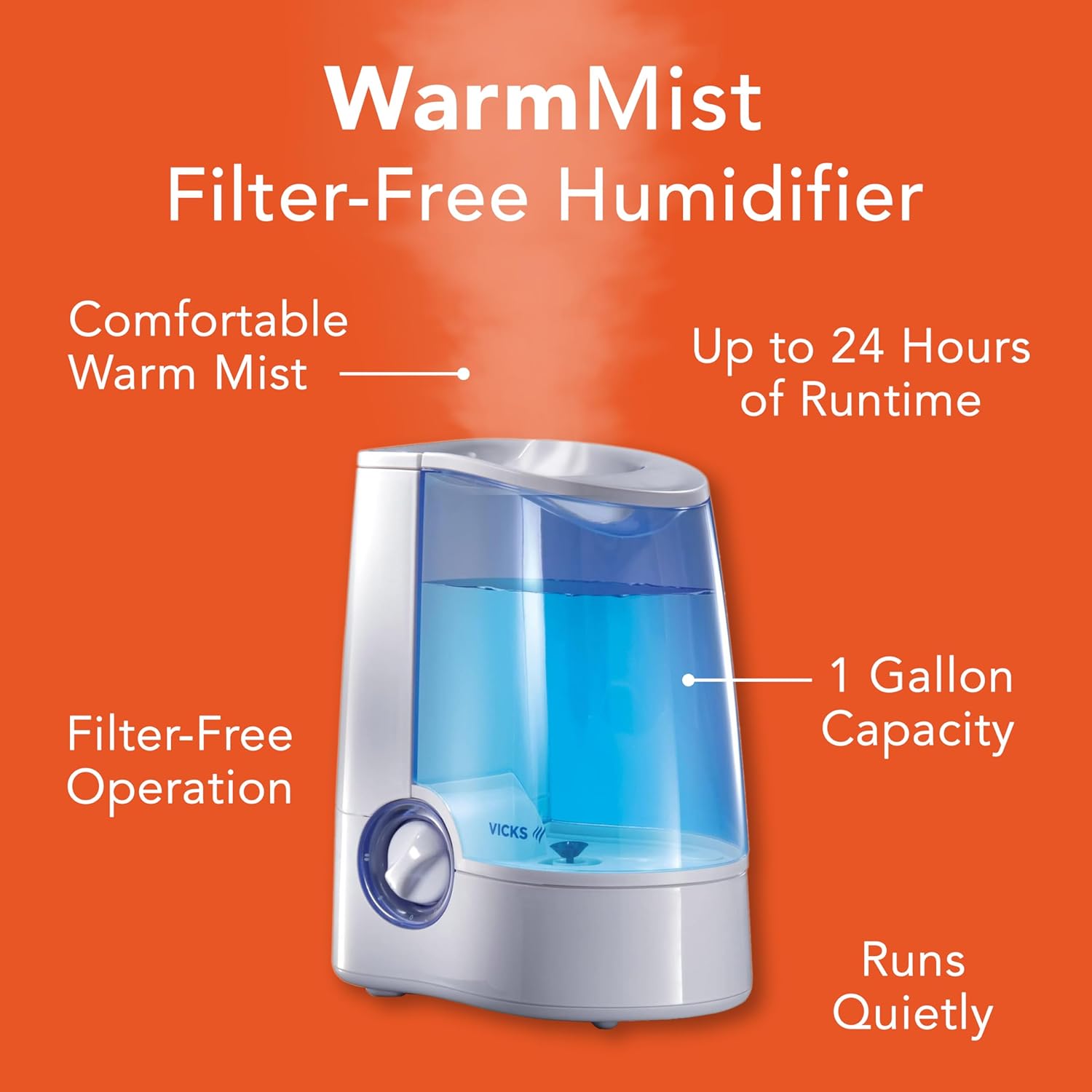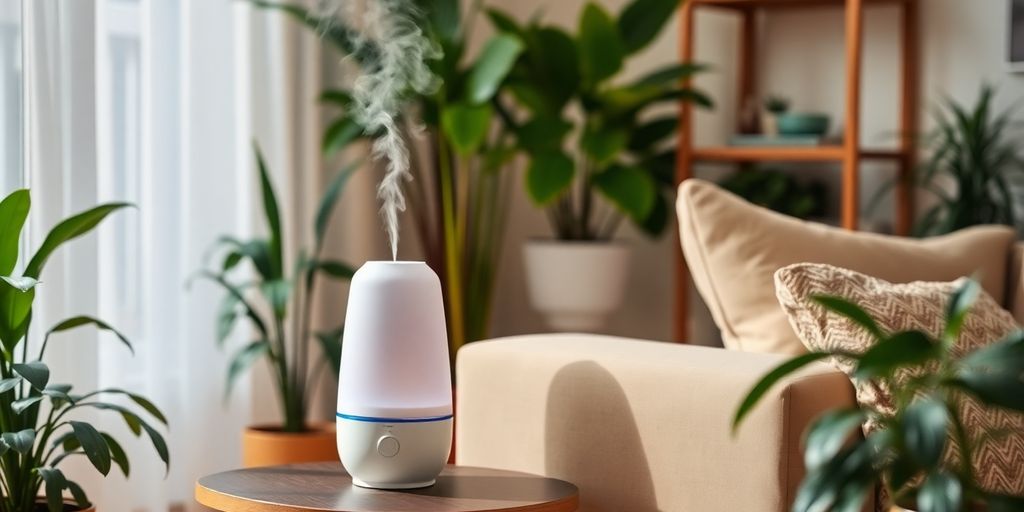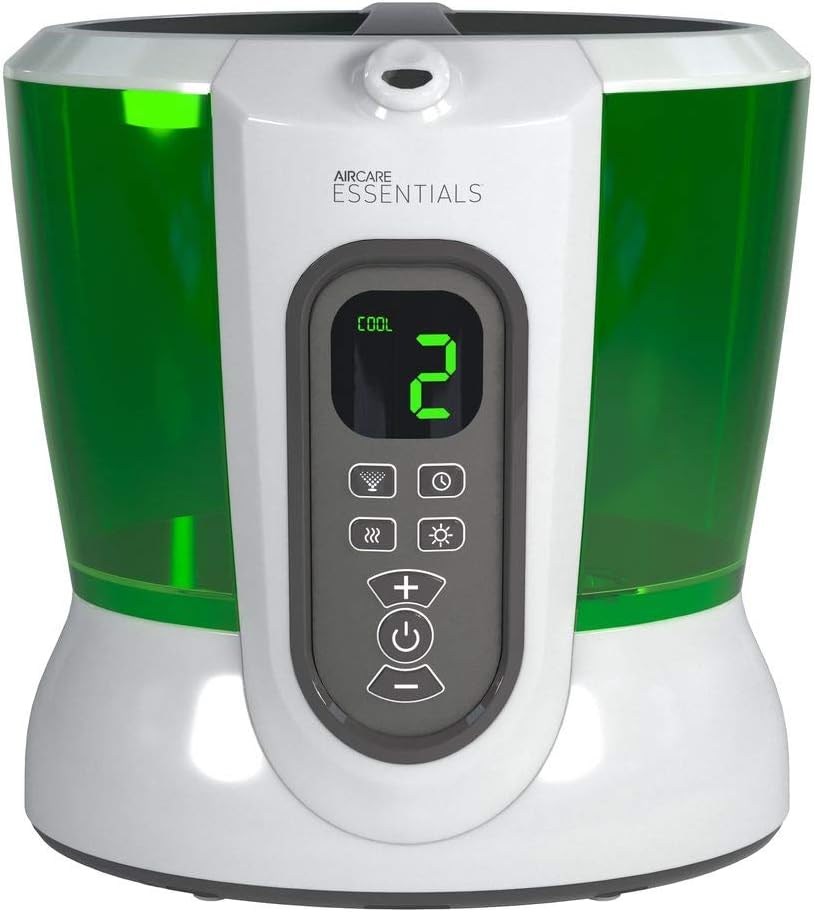Understanding Room Size and Humidifier Needs
Why Room Size Matters
So, you’re thinking about getting a humidifier? Smart move! But before you click ‘add to cart,’ let’s talk about room size. It’s not just a suggestion; it’s the most important factor in picking the right humidifier. A humidifier that’s too small won’t do much, and one that’s too big can make your room feel like a rainforest. Think of it like trying to cool your whole house with a tiny fan – not gonna work, right? The humidifier sizing guide is your friend here.
Consequences of Choosing the Wrong Size
Okay, so what happens if you mess up the humidifier size? Here’s the deal:
- Too Small: You’ll waste money and energy. The humidifier will run constantly, trying to reach the set humidity, but it’ll never quite get there. Plus, you won’t feel any relief from dry air.
- Too Big: Over-humidifying can lead to condensation, mold growth, and a generally uncomfortable, clammy feeling. Nobody wants that! It can also damage wooden furniture and promote dust mite growth. Yuck.
- Energy Waste: An improperly sized unit will work harder than it needs to, driving up your electricity bill. It’s all about finding that sweet spot.
How Humidity Affects Comfort
Humidity plays a huge role in how comfortable you feel. When the air is too dry, you might experience:
- Dry skin and chapped lips
- Sinus irritation and nosebleeds
- Aggravated asthma or allergies
- Static electricity
On the flip side, too much humidity can make you feel sticky and uncomfortable. The ideal room humidity levels and devices can help you maintain a healthy and comfortable environment, usually between 30-50%. Getting the right humidifier is key to achieving that balance.
Identifying Small Room Requirements
Characteristics of Small Rooms
Okay, so what exactly is a small room? Generally, we’re talking about spaces that are 400 square feet or less. Think bedrooms, small offices, or maybe a tiny studio apartment. Because the space is limited, you don’t need a huge, powerful humidifier. In fact, going too big can actually make the room too humid, which is just as bad as it being too dry. These rooms often benefit from a humidifier that’s easy to move around and doesn’t take up a ton of space.
Recommended Humidifier Capacity
For these smaller rooms, you’ll want to look for a humidifier with a tank capacity of less than 1.5 gallons. This size is usually sufficient to maintain the proper humidity levels without overdoing it. Here’s a quick guide:
- Room Size: Up to 400 sq ft
- Humidifier Capacity: Less than 1.5 gallons
- Ideal Use: Bedrooms, small offices, nurseries
Best Types of Humidifiers for Small Spaces
When it comes to small rooms, some types of humidifiers work better than others. Here are a few good options:
- Ultrasonic Humidifiers: These are super quiet, which is great for bedrooms. They use vibrations to create a fine mist. Plus, they often come in smaller sizes perfect for single room humidifying.
- Evaporative Humidifiers: These use a fan to blow air through a wet wick, which evaporates water into the air. They’re generally affordable and self-regulating, meaning they won’t over-humidify the room.
- Cool Mist Humidifiers: These are a good choice if you have kids or pets, as there’s no hot water involved. They’re also energy-efficient.
Avoid large console humidifiers or whole-house systems unless you really want to turn your small room into a sauna. Trust me, you don’t.
Choosing for Medium-Sized Rooms

Defining Medium Room Dimensions
Okay, so you’re not dealing with a tiny space, but not a huge one either. What exactly counts as a medium-sized room when we’re talking humidifiers? Generally, we’re looking at rooms between 400 and 1,000 square feet. Think of a large bedroom, a decent-sized living room, or maybe a small office space. It’s important to get this right because the wrong humidifier can be ineffective or overkill.
Ideal Humidifier Output
For these medium-sized rooms, you’ll want a humidifier that can handle between 1 and 3 gallons of water per day. This output ensures that the humidity levels are adequately raised without making the room feel damp or stuffy. A humidifier with Wi-Fi connectivity can be a great option, allowing you to monitor and adjust humidity levels remotely.
To give you a clearer picture:
| Room Size | Humidifier Capacity |
|---|---|
| 400-1,000 sq ft | 1-3 gallons |
Popular Models for Medium Spaces
When it comes to choosing a humidifier for a medium-sized room, you’ve got options. Tower humidifiers are a popular choice because they don’t take up too much floor space. Here are a few things to consider:
- Ultrasonic Humidifiers: These are quiet and use cool mist, which is great if you have kids or pets.
- Evaporative Humidifiers: These use a fan to blow air through a wet wick, naturally humidifying the air. They’re self-regulating, so they won’t over-humidify the room.
- Consider the Features: Look for things like adjustable humidity settings, automatic shut-off, and easy-to-clean components. A top humidifier should be easy to maintain and operate.
Don’t just grab the first one you see. Read reviews, compare features, and think about what’s most important to you in terms of noise level, maintenance, and overall performance. Getting the right humidifier can really make a difference in your comfort and health!
Selecting Humidifiers for Large Rooms
What Constitutes a Large Room?
Okay, so what exactly is a large room when we’re talking about humidifiers? Generally, if you’re dealing with a space over 1000 square feet, you’re in large room territory. Think open-plan living areas, finished basements, or even multiple smaller rooms that are open to each other. The key is the total volume of space that needs humidifying. It’s not just about the floor area; ceiling height plays a role too. A room with high ceilings will need a more powerful humidifier than a room with standard ceilings, even if the floor space is the same.
Capacity Needs for Larger Spaces
For large rooms, you’ll need a humidifier with a substantial output. Forget those little tabletop models! We’re talking about needing a humidifier with a capacity of over 3 gallons. Console humidifiers are often a good choice here. These units are designed to handle larger areas and can output a significant amount of moisture. You might even consider a whole-house humidifier if you want to humidify your entire home. Here’s a quick guide:
- Console Humidifiers: Typically output 6-9+ gallons per day, suitable for one or two large rooms.
- Whole-House Humidifiers: Integrate with your HVAC system and can humidify an entire house (2,500-3,000 sq ft).
Remember, it’s always better to go slightly bigger than you think you need. You can always turn the humidifier down, but you can’t make it put out more moisture than it’s designed for. This is important when thinking about how to choose a humidifier.
Types of Humidifiers Suitable for Large Areas
When it comes to large rooms, a few types of humidifiers stand out:
- Evaporative Humidifiers: These use a fan to blow air through a wet wick or filter, evaporating water into the air. They’re generally self-regulating, as the rate of evaporation depends on the humidity level in the room. They are a good choice when considering the best humidifier for room size.
- Ultrasonic Humidifiers: These use high-frequency sound vibrations to create a fine mist. They’re quiet and efficient, but can sometimes produce white dust if you have hard water. They are a good choice when considering the humidifier capacity for rooms.
- Console Humidifiers: These are larger, freestanding units that combine the features of evaporative or ultrasonic humidifiers with a larger water tank and greater output capacity. They’re designed specifically for humidifying larger spaces.
Consider the pros and cons of each type before making a decision. For example, evaporative humidifiers require regular wick replacement, while ultrasonic humidifiers need more frequent cleaning to prevent mineral buildup.
Factors Beyond Room Size
Okay, so you’ve measured your room and have a general idea of what size humidifier you need. Awesome! But hold on a sec – room size isn’t the only thing to think about. There are a few other things that can affect which humidifier is best for you. Let’s take a look.
Type of Humidifier
There are several types of humidifiers, and each has its own pros and cons. You’ve got cool mist humidifiers, warm mist humidifiers, ultrasonic humidifiers, and evaporative humidifiers. Cool mist humidifiers are great for kids’ rooms because there’s no risk of burns, while warm mist humidifiers can help relieve cold symptoms. Ultrasonic humidifiers are super quiet, and evaporative humidifiers are pretty energy-efficient. The type you choose can impact how well it works in your space, regardless of the room’s size.
Frequency of Use
How often do you plan on running your humidifier? If you only need it occasionally, like when you have a cold or during the driest months, a smaller, less expensive model might be fine. But if you plan to run it constantly, especially in a larger space, you’ll want something more robust. Think about the water tank capacity and how often you’ll need to refill it. Nobody wants to be constantly running to the sink!
Mobility Considerations
Are you planning to keep your humidifier in one spot, or do you want to move it around the house? If you want to move it, consider a smaller, lighter model with a handle. If it’s going to live in one place, you might not care as much about its portability. Also, think about where you’ll put it. Does it need to be near an outlet? Will it be on a carpet or a hard floor? These things can affect your choice.
Budgeting for Your Humidifier

Understanding Price Ranges
Okay, so you’re ready to buy a humidifier, but how much are we talking? The price can really vary depending on the size, type, and features. You can find small, basic humidifiers for as little as $20-$30. But if you’re looking at something for a larger room or with more bells and whistles (like a built-in humidistat or essential oil diffuser), you could easily be spending $100 or more. It’s a good idea to set a budget before you start shopping so you don’t get sticker shock.
Cost vs. Features
Think about what features are actually important to you. Do you really need that fancy digital display, or would a simple on/off switch do the trick? Sometimes, paying a little extra for a humidifier with better reviews or a longer warranty is worth it in the long run. Here’s a few things to consider:
- Humidistat: This automatically adjusts the humidity level, which can save energy.
- Filter Type: Some humidifiers have filters that need replacing, adding to the cost.
- Tank Size: A bigger tank means less frequent refills, but also a higher price.
Long-Term Savings with the Right Size
Getting the right size humidifier isn’t just about comfort; it can also save you money. A humidifier that’s too small will run constantly, wasting energy and potentially burning out faster. One that’s too big could lead to excessive humidity, which can cause mold and other problems. So, doing your homework and picking the right size can actually save you money on energy bills and prevent costly repairs down the road. Plus, you won’t have to replace it as often!
Maintenance Tips for Your Humidifier
Regular Cleaning Practices
Okay, so you’ve got your humidifier, and it’s doing its thing, pumping moisture into the air. Great! But here’s the deal: these things need cleaning. Like, regularly. Think of it this way: a dirty humidifier is basically a breeding ground for mold and bacteria, and you definitely don’t want to be breathing that in. Aim to clean your humidifier at least once a week, or even more often if you notice any buildup.
Here’s a simple routine:
- Unplug the humidifier. Safety first!
- Empty the tank and rinse it out. Get rid of any standing water.
- Use a soft brush or cloth to scrub the inside of the tank with a mixture of water and white vinegar. This helps to remove mineral deposits and grime.
- Rinse thoroughly with clean water.
- Let all the parts air dry completely before reassembling.
For some models, you can even put the tank in the dishwasher (check the manual first!). Also, don’t forget to clean or replace the filter regularly, if your humidifier has one. A clean filter means cleaner air.
Signs Your Humidifier Needs Attention
Sometimes, your humidifier will tell you it needs some TLC. You just have to know what to look for. Here are a few red flags:
- Visible mold or mildew: If you see any mold or mildew growing inside the tank or on other parts of the humidifier, it’s time for a deep clean. And maybe consider cleaning it more often in the future.
- Unpleasant odors: A funky smell coming from your humidifier is a sign that bacteria or mold are present. Time to break out the vinegar!
- Reduced output: If your humidifier isn’t producing as much mist as it used to, it could be due to mineral buildup or a clogged filter. Cleaning or replacing the filter might do the trick.
- Mineral deposits: White, crusty stuff inside the tank? That’s mineral buildup from hard water. Vinegar is your friend here.
If you notice any of these signs, don’t ignore them. Addressing the issue promptly will help keep your humidifier running smoothly and prevent it from becoming a health hazard.
How to Extend the Life of Your Humidifier
Want to keep your humidifier running for years to come? Here are a few tips to help you extend its lifespan:
- Use distilled water: Tap water contains minerals that can build up inside the humidifier and cause problems. Distilled water is much cleaner and will help prevent mineral deposits.
- Clean it regularly: We’ve already talked about this, but it’s worth repeating. Regular cleaning is the key to keeping your humidifier in good condition.
- Replace the filter: If your humidifier has a filter, replace it according to the manufacturer’s instructions. A clean filter will help your humidifier run more efficiently and prevent it from getting clogged.
- Store it properly: When you’re not using your humidifier, make sure to empty it completely and clean it thoroughly before storing it. Store it in a cool, dry place to prevent mold and mildew growth.
- Read the manual: Seriously, take a few minutes to read the owner’s manual. It contains valuable information about how to properly use and care for your specific humidifier model.
By following these simple tips, you can keep your humidifier running smoothly and efficiently for years to come. And that means cleaner, healthier air for you and your family.
Wrapping It Up
So, there you have it! Choosing the right size humidifier really comes down to the size of your room. Remember, a small humidifier in a big space won’t do much good, and a giant one in a tiny room could lead to some serious moisture issues. Just keep in mind the square footage and how often you plan to use it. Whether you’re dealing with dry winter air or just want to keep things comfy, picking the right humidifier can make a world of difference. Happy shopping, and may your air be perfectly humidified!




